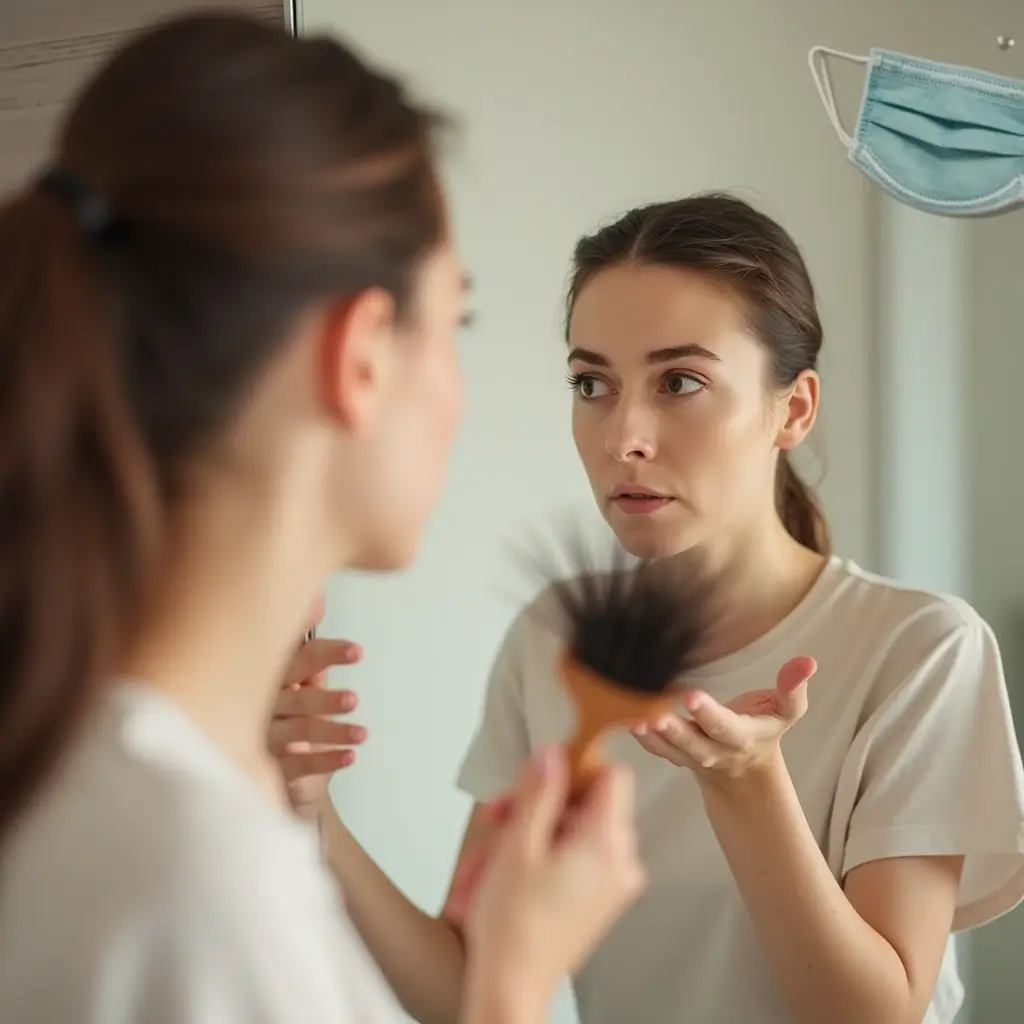Losing your hair after a COVID-19 infection is more common than you might think. You’ve spent months, if not longer, dealing with the physical and emotional toll of the virus, only to be confronted with the added stress of hair loss. If you’ve noticed more strands than usual in your brush or on your pillow, you’re not alone. Many individuals are facing similar challenges in the wake of COVID-19 recovery, and the emotional impact can be just as overwhelming as the illness itself.
COVID hair loss is a real concern, but the good news is that it is usually temporary, and with the right approach, your hair can recover. Let’s walk through everything you need to know about this phenomenon, including what causes it, how long it lasts, and the steps you can take to support your regrowth journey. Whether you’re dealing with hair shedding or more severe hair loss, understanding the process and managing expectations can provide a sense of relief as you navigate this difficult experience.
What Is COVID Hair Loss? Understanding the Connection
COVID-19 and Hair Loss: What’s Happening?
COVID-19 is a novel virus, and its impact on the body extends beyond the usual symptoms of fever, cough, and fatigue. One of the less talked about effects that many people experience after recovering from COVID-19 is hair loss, which can be alarming and frustrating. But why does this happen?
Hair loss linked to COVID-19 is typically caused by a condition known as telogen effluvium, a form of temporary hair shedding. Under normal circumstances, about 90% of the hairs on your scalp are in the active growth phase, while 10% are in the resting (telogen) phase. When you go through a stressful event, such as an illness or fever, your body may push a larger proportion of your hair into the telogen phase, causing increased shedding.
In some cases, the virus can also trigger or worsen a condition known as alopecia areata, an autoimmune disorder that causes patchy hair loss. While this is less common, it’s important to be aware of the possibility, especially if you already have a history of autoimmune conditions.

Why Does COVID Cause Hair Loss?
The exact mechanisms behind COVID-related hair loss are still being studied, but there are several factors at play:
- Stress Response: The physical and emotional stress of fighting off a viral infection like COVID-19 can cause your body to redirect its resources, leading to an increased number of hair follicles shifting into the shedding phase.
- Fever and Inflammation: COVID-19 often brings about fever, which can also be a trigger for telogen effluvium. High body temperatures can disrupt the normal hair growth cycle, pushing hair follicles prematurely into the shedding phase.
- Immune System Changes: COVID-19, like many viral infections, can disrupt the immune system, which may lead to autoimmune responses that impact the hair follicles. For those with preexisting autoimmune conditions, COVID could trigger flare-ups, exacerbating hair loss.
The Timeline of COVID Hair Loss: What to Expect
When Does Hair Loss Start After COVID-19?
If you’ve recovered from COVID-19 and are noticing increased hair shedding, you may be wondering when to expect it—and how long it will last. Here’s the typical timeline:
- Initial Symptoms: For most people, hair loss doesn’t occur immediately after the illness itself. Instead, shedding usually begins about 2 to 3 months after recovery. This delay happens because hair follicles undergo a prolonged cycle before the shedding phase becomes noticeable.
- Peak Shedding: Hair shedding tends to peak around 3 to 4 months after the infection. This is when you may notice an increase in the amount of hair lost during brushing or washing.
How Long Does Hair Shedding Last?
The good news is that COVID hair loss is usually temporary. The shedding phase typically lasts for 3 to 6 months, after which your hair follicles begin to recover. Most people will see gradual regrowth within that time frame, although it may take several months for your hair to return to its previous thickness and length.
It’s important to note that telogen effluvium doesn’t cause permanent follicle damage, meaning your hair will likely regrow once the shedding phase ends. However, it’s worth being patient—hair growth is slow, averaging about 1 cm per month.
Dealing with COVID Hair Loss: Tips for Recovery
While hair loss after COVID-19 can feel discouraging, there are steps you can take to support the regrowth process and manage your hair health.
1. Practice Patience—Most Hair Loss Is Temporary
It’s natural to feel anxious when you notice more hair falling out than usual, but remember that COVID-related hair loss is typically temporary. With time, your hair will return to its normal growth cycle, and the shedding will slow down. It may take 3-6 months for the shedding to subside and another 6-12 months for full regrowth, depending on your hair growth rate.
2. Nutrition and Supplements to Support Hair Regrowth
One of the best things you can do to help your hair regrow is to focus on your diet and nutrition. Hair health is influenced by your overall wellness, so providing your body with the right nutrients can play a big role in speeding up the recovery process.
Foods to Include:
- Vitamin D: This vitamin is essential for hair follicle cycling and can be found in fatty fish, fortified dairy products, and egg yolks.
- Biotin: This B-vitamin is known for its role in promoting healthy hair. Include eggs, nuts, seeds, and leafy greens in your diet.
- Iron: Iron deficiencies can contribute to hair loss, so make sure to consume spinach, red meat, and lentils.
- Omega-3 Fatty Acids: Found in salmon, flaxseeds, and walnuts, omega-3s help nourish hair follicles.
Supplements:
- Biotin supplements are widely recommended for promoting hair growth.
- Vitamin D and Iron supplements may also help if you’re deficient in these nutrients.
Here’s a quick table of key nutrients and foods to support hair health:
| Nutrient | Foods to Include |
|---|---|
| Vitamin D | Fatty fish, fortified dairy products |
| Biotin | Eggs, nuts, seeds |
| Iron | Spinach, red meat, lentils |
| Omega-3s | Salmon, flaxseeds, walnuts |
3. Stress Management for Hair Health
Stress can be a significant factor in hair loss, and managing your stress levels is crucial for your recovery. Practices like meditation, yoga, and deep breathing exercises can help you reduce stress, which in turn may support hair regrowth. Additionally, maintaining good mental health is key to reducing the impact of stress on your overall well-being.
4. Consulting a Dermatologist
If your hair loss persists for several months or seems to be worsening, it’s important to consult a dermatologist. A professional can help determine whether your hair loss is related to COVID-19 or if another underlying condition is at play.
For some, dermatologists may recommend minoxidil (Rogaine) or other topical treatments to stimulate hair growth. In more severe cases, treatments like corticosteroids or immunosuppressants may be necessary, especially if there’s an underlying autoimmune condition like alopecia areata.

Alopecia Areata and COVID: A Rare but Possible Link
While the most common form of hair loss after COVID is telogen effluvium, it’s important to be aware that COVID-19 can trigger or worsen alopecia areata in some individuals.
Alopecia areata is an autoimmune disorder where the body mistakenly attacks hair follicles, causing patchy hair loss. If you have a history of alopecia areata or other autoimmune conditions, COVID could potentially trigger a flare-up, leading to more severe hair loss.
If you notice patchy hair loss or other symptoms related to alopecia areata, it’s essential to seek advice from a dermatologist. There are several treatment options available for managing alopecia areata, including corticosteroid injections and JAK inhibitors.
Is COVID Hair Loss Permanent?
The good news is that COVID-related hair loss is typically not permanent. Hair loss caused by telogen effluvium doesn’t result in permanent follicle damage, so once your hair enters the regrowth phase, it should eventually recover. However, it can take time—up to a year for your hair to return to its original thickness and length.
As your hair grows back, it’s important to be patient and gentle with your hair. Avoid excessive heat styling, chemical treatments, or tight hairstyles that could stress your follicles further.
Frequently Asked Questions About COVID Hair Loss
1. How soon after COVID-19 infection will I notice hair loss?
Hair loss usually begins 2-3 months after recovery as your body adjusts to the stress caused by the virus and fever.
2. Is COVID-related hair loss temporary?
Yes, most cases of COVID-related hair loss are temporary. While shedding may occur for a few months, hair generally begins to regrow after the shedding phase ends.
3. Can I do anything to speed up hair regrowth after COVID?
While there’s no quick fix, maintaining a healthy diet, managing stress, and consulting a dermatologist can help support the regrowth process.
4. Does everyone who gets COVID experience hair loss?
No, not everyone will experience hair loss after COVID, but studies suggest that about 20% of people report increased hair shedding post-recovery.
You’re Not Alone—COVID Hair Loss Is Temporary and Treatable
If you’ve noticed hair loss after COVID-19, know that you’re not alone, and this is a common but temporary side effect of the virus. With patience, proper nutrition, stress management, and professional care when needed, your hair will likely recover over time. Remember to be gentle with yourself and allow your body the time it needs to heal. Hair loss can be distressing, but rest assured that the shedding will likely slow down, and regrowth will follow.
If you’re struggling with hair loss, don’t hesitate to seek advice from a dermatologist. They can offer solutions tailored to your specific needs. Your hair may be in recovery, but with the right steps, you can regain your confidence and your hair.

